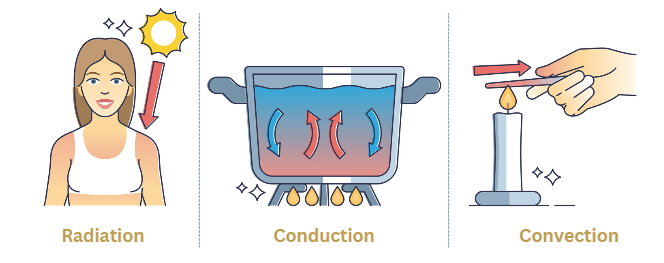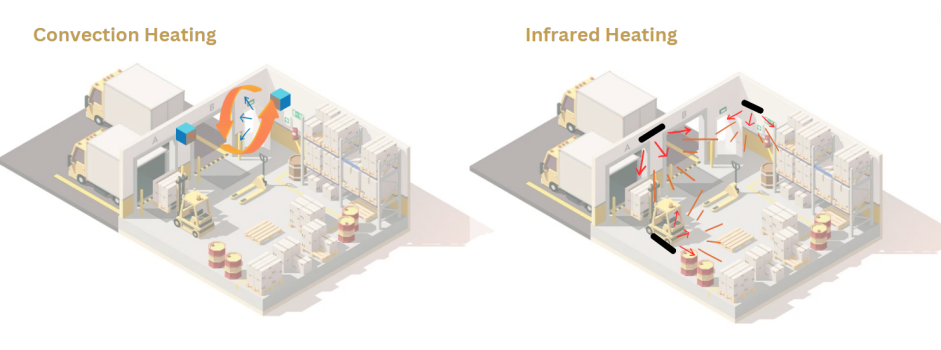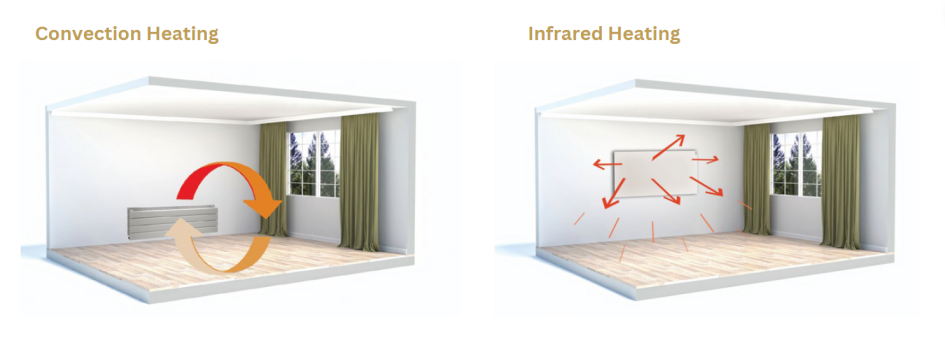The options for greener heating systems are an important topic of discussion in 2024, with all roads pointing to a shift in businesses and consumers lowering their emissions use.
With there never being a better time to consider eco-friendly heating solutions, Tansun research and evidence what infrared heat is, how it works and why it’s different from other forms of heat transfer.
Infrared Heating - How Does It Work [1]
- Radiant heat transfer reduces cycle times, focusing energy directly on the target and does not require any additional expensive and insulated enclosures to trap and recirculate heat
- Has high efficiency, more than 90% emission is possible within 1 second and more than 85% of consumed energy is transferred into IR heat
- Is clean and compact, with no pollution or emission by-products - considered to be environmentally friendly
|
How Was Infrared Discovered?
Infrared radiation was discovered in the early 19th century by Sir William Herschel, a British astronomer during experiments with sunlight
[2]. While investigating the distribution of different colours using sunlight via a prism, Herschel observed an increase in temperature which occurred beyond the red end of the spectrum where there was no visible light. The unexpected heat lead to the discovery of infrared radiation, making a pivotal moment in our understanding of the electromagnetic spectrum and its applications – including heating.
Infrared Wavelength
On the electromagnetic spectrum, infrared radiation falls between visible light and microwaves with a longer wavelength than visible light but a shorter wavelength than microwaves. The wavelength of infrared radiation plays a crucial role in its heating capabilities, as it directly influences its ability to penetrate and interact with objects. Understanding this spectrum positioning provides insight into how infrared heating efficiently transfers warmth through radiation.

Caption: The Electromagnetic Spectrum, Showcasing Infrared Wavelength and How Infrared Heating Works
How Does Infrared Heating Work?
Infrared heating operates through the principle of radiant heat which involves the direct transfer of heat from the heater to objects and individuals within a space, bypassing the heater of air in between
[3]. Infrared heating primarily uses radiation as the mode of heat transfer. Objects within the room absorb emitted infrared rays, raising their temperature for some time. This absorbed heat is then released back into the room through three main mechanisms, conduction, convection and radiation.

Caption: Thermal Heat Transfer, Infrared Uses Radiation
|
Radiation
|
- The fundamental mode of heat transfer in infrared heating, operates through the direct transmission of heat energy from the infrared source to its directed target without being impacted by an intermediary medium like air, wind or draughts.
- This direct transfer of heat ensures efficient warming of individuals and objects in a room which creates a sensation similar to basking in the warmth of sunlight.
|
|
Convection
|
- Involves the transfer of heat energy through the air, with the heated individuals and objects radiating heat back into the surrounding air, which then circulates to heat through the process of convection indirectly.
- Although infrared heating primarily relies on radiation, convection can still occur to a lesser extent within the room.
|
|
Convection
|
- Occurs as heat energy is transferred through direct contact between surfaces.
- For example, when striking a match and lighting a candle, heat is conducted from the match to the candle.
- Or when sitting on a chair warmed by infrared radiation – heat is conducted from the chair to the body.
|
Infrared vs Convection Heater
An infrared heater is essentially a very contemporary take on the commercial and domestic heating landscape, leveraging the principles of infrared radiation to form more targeted, directional heating where and when needed. This operates in a vastly different manner to traditional heating styles which makes use of the convection process to warm up.
Infrared vs Convection Heater Comparison – Industrial

In an industrial commercial setting, the choice between infrared heaters and traditional convection heating systems, like commercial warm-air heaters, hinges on efficiency and effectiveness.
While convection heaters aim to warm a large volume of space uniformly, infrared heaters target specific areas or objects, providing warmth precisely where needed. Research indicates that in scenarios requiring heating for expansive spaces, infrared heaters demonstrate superior energy efficiency, consuming up to half the energy of unit heaters commonly used in such settings
[4].
The warmth generated by infrared heaters is also immediate, contrasting with the gradual warmth provided by convection heaters. Additionally, convection heaters often suffer from heat loss due to poor heat distribution, as warm air tends to rise, leaving lower areas cooler. This disparity underscores the advantages of infrared heating in industrial commercial environments, where efficiency, targeted warmth, and rapid heat delivery are paramount.
Infrared vs Convection Heater Comparison – Domestic and Offices

In contemporary settings such as dynamic, agile and flexible workspaces or home environments, radiant panel heaters that utilise infrared offer unparalleled advantages compared to traditional wall-mounted convection heaters.
Radiant panel heaters offer the advantage of zoning, allowing for precise control over heating in specific areas as needed. This level of flexibility aligns well with the dynamic nature of modern workspaces and home environments, where adaptability and agility are crucial. Unlike convection heaters, which aim to uniformly heat large volumes of space, radiant panel heaters provide customisable warmth exactly where it's required, optimising comfort and energy efficiency. This versatility caters to the evolving needs of modern spaces, ensuring optimal heating solutions for varied and dynamic environments.
Types of Infrared Heating
A more in-depth overview of
different types of infrared heating is available in our detailed analysis here, detailing the various applications, benefits and how some of its drawbacks can be overcome as part of an all-round heating solution in various spaces.
Does Infrared Heating Work?
|
Efficiency
|
- Infrared heating boasts remarkable efficiency due to its direct transfer of heat to objects and individuals, bypassing the heating of the surrounding air.
|
|
Heat Transfer
|
- Generally, colour is a good indicator of heat output in which the best radiation heat transfer efficiency occurs when the heater glows red [1].
- This emphasies why various types of infrared is used for different heating applications and scenarios where lower glare is more suitable.
|
|
Energy Savings
|
- Infrared heating systems offer significant energy savings compared to tradtional heating methods, particularly in larger spaces.
- By directly warming objects and individuals, infrared heaters require less energy to achieve the desired level of warmth - leading to reduced energy consumption and lower utility costs over time.
|
|
Flexibility
|
- One of the key advantages of infrared heating lies in its flexibility.
- Whether used in industrial, commercial or residential settings, infrared heaters can be tailored to meet specific heating requirements, offering zoning capabilities to provide warmth precisely where needed.
- This adaptability makes them well-suited for dynamic environments where heating needs may vary and be interchangeable.
|
|
Controllability
|
- Infrared heating systems offer precise controllability, allowing users to adjust heating levels according to preference and occupancy.
- With advanced control options such as modulation (dimming), set-point temperature control and built-in presence detectors, users can automate comfort while minimising energy usage - enhancing the overall efficiency and effectiveness of the heating system.
|
The rise of infrared heating signifies a transformative shift in how we approach warmth and comfort. Its unparalleled efficiency, precise controllability, and adaptability to diverse settings herald a new era of heating solutions. As we navigate to a more sustainable future, infrared heating as a cleaner energy-saving alternative becomes increasingly undeniable.
Tansun have compiled this detailed overview to explain how infrared heating works, shedding light on its remarkable potential.
If you have any questions then please get in touch on 0121 580 6200, email sales@tansun.com or follow us on LinkedIn to keep up to date with new case studies, news and technical pieces.
Sources:
[1] Pan, Z. and Atungulu, G.G., 2010. Infrared heating for food and agricultural processing. CRC Press. pp. 57-70.
[2] Ring, E.F.J., 2000. The discovery of infrared radiation in 1800. The Imaging Science Journal, 48(1), pp. 1-8.
[3] Brown, K.J., Farrelly, R., O’shaughnessy, S.M. and Robinson, A.J., 2016. Energy efficiency of electrical infrared heating elements. Applied Energy, 162, pp. 581-588.
[4] Roth, K., Dieckmann, J. and Brodrick, J., 2007. Infrared radiant heaters. Ashrae Journal, 49(6), p.72.